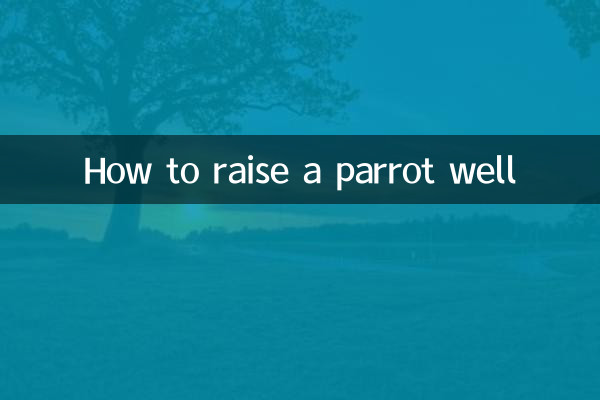How to raise a parrot well
Parrots are smart, lively pets, but raising them requires scientific methods and careful care. The following is a detailed guide on how to raise parrots. It combines the hot topics and hot content on the Internet in the past 10 days to provide you with structured data and suggestions.
1. Basic needs of parrots

Before raising a parrot, you must first understand their basic needs, including diet, living environment, and social interaction. The following are the core points of raising parrots:
| Requirement Category | Specific content |
|---|---|
| diet | Mainly special parrot food, with fresh fruits, vegetables and nuts |
| living environment | Spacious cage, protected from direct sunlight and cold drafts |
| social interaction | At least 1-2 hours of interaction time every day to avoid loneliness |
| health check | Observe feathers, feces and behavior regularly, and seek medical attention promptly if any abnormalities are found |
2. Key points for raising popular parrot species
Different species of parrots have slightly different ways of raising them. The following are the recently popular parrot species and their feeding precautions:
| variety | Features | Difficulty of raising |
|---|---|---|
| budgerigar | Small size, suitable for novices, soft bark | Low |
| cockatiel | Mild personality, easy to get close to people | middle |
| african gray parrot | High IQ and good at imitating human language | high |
| macaw | Large, long-lived, requires a lot of space | high |
3. Precautions for parrot diet
A parrot's diet directly affects its health and lifespan. The following are recent popular parrot diet suggestions:
1.Staple food selection: Choose high-quality parrot-specific food and avoid feeding single food.
2.Fruits and vegetables: Apples, bananas, carrots, etc. can be fed in moderation, but toxic foods such as avocados and chocolates should be avoided.
3.drink water: Change clean drinking water every day to avoid using chlorine in tap water, which may harm your parrot.
4. Health management of parrots
Parrot health issues are one of the hot topics these days. The following are common health issues and preventive measures:
| health problems | symptom | Precautions |
|---|---|---|
| feathers falling off | Sparse feathers and exposed skin | Provide a balanced diet to avoid stress |
| respiratory tract infection | sneezing, shortness of breath | Keep the environment clean and avoid moisture |
| obesity | Slow movement and overweight | Control your diet and increase exercise |
5. Behavior training of parrots
Training parrots is one of the most popular topics recently. Here are the basic steps for training a parrot:
1.build trust: Get the parrot familiar with its owner through feeding and gentle interaction.
2.basic instructions: Start training with simple "up" and "down" and gradually increase the difficulty.
3.Reward mechanism: Use treats or praise as rewards to reinforce your parrot’s positive behavior.
6. Common misunderstandings about raising parrots
The following are feeding misunderstandings that have been discussed frequently recently for your reference:
1.The bigger the cage, the better: The size of the cage should be suitable for the size of the parrot. If it is too large, it may make the parrot feel uneasy.
2.bathe frequently: Parrots do not need to be bathed every day, just 1-2 times a week. Excessive bathing may cause colds.
3.Neglect social interaction: Parrots are highly social animals, and being alone for long periods of time can lead to depression or behavioral problems.
Conclusion
Raising parrots is a task that requires patience and responsibility. Through scientific feeding methods and careful care, you can let your parrot grow up healthily and happily. I hope the structured data and popular content in this article can provide you with practical help.

check the details

check the details